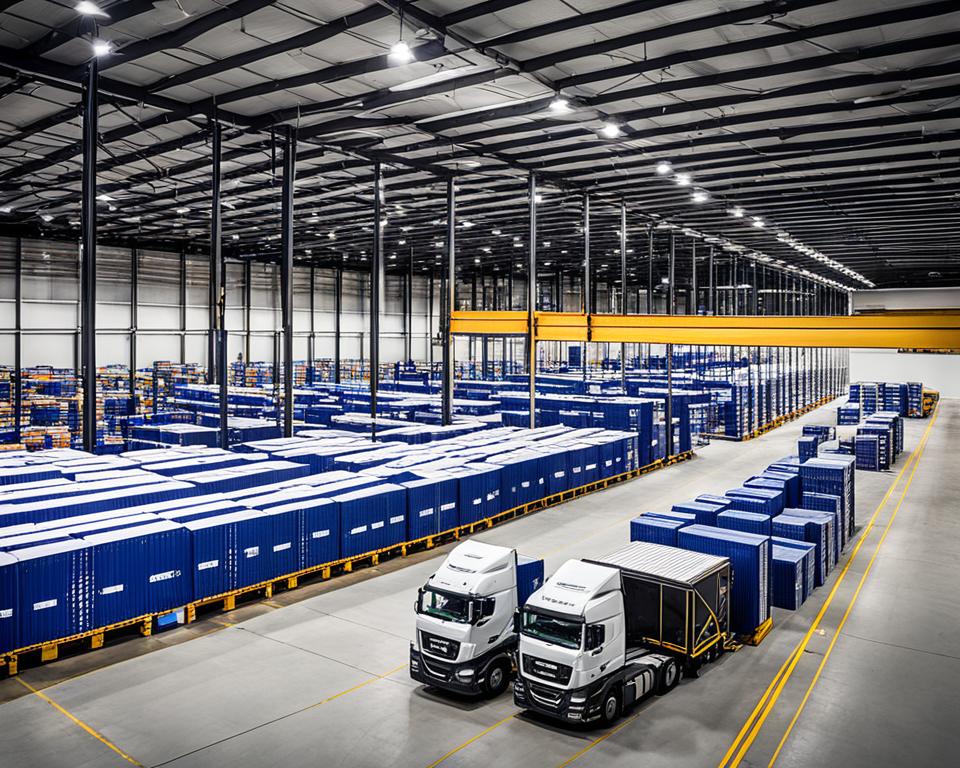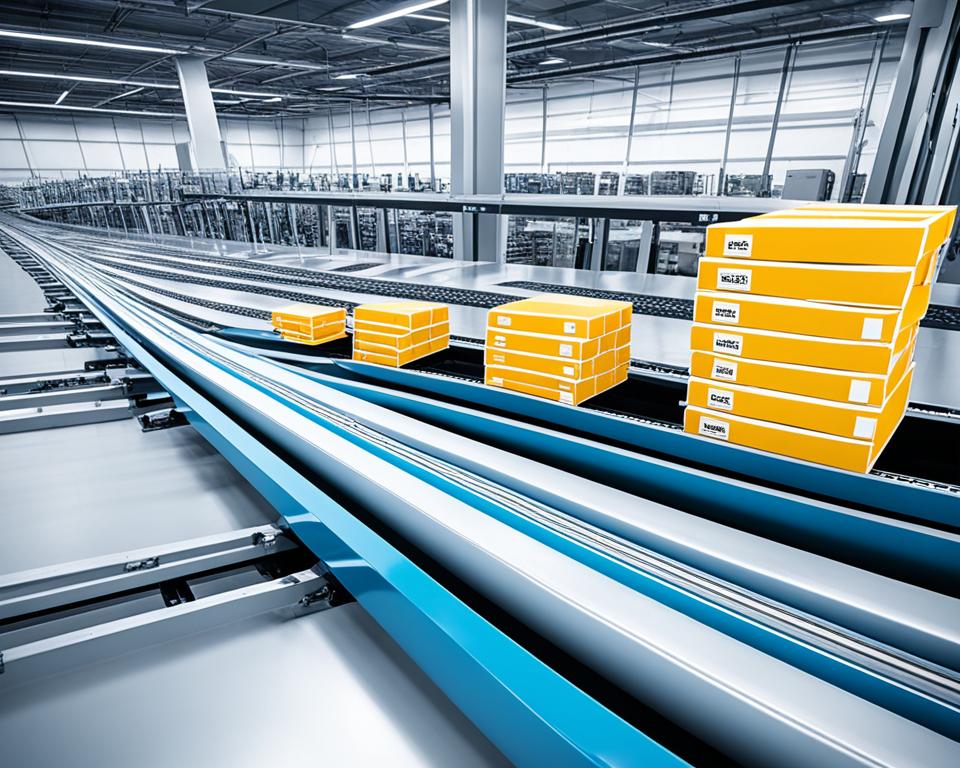Have you ever seen some companies handle supply chain issues smoothly, while others seem stuck? The secret is often in the tools they use, like SAP EM. This tool helps with Event Management and makes Supply Chain Management better with Real-Time Insights. By using SAP EM, companies can change how they manage and watch their supply chains. This makes them work better and adapt quickly to changes.
In this article, we’ll see how SAP EM helps with making smart decisions and avoiding risks. This leads to better performance. With the right information, companies can handle events as they happen, reducing problems and staying flexible. You’ll learn how using SAP EM fully can help businesses grow and succeed in today’s tough market.
To learn more about SAP and programming languages like ABAP, check out this helpful resource: Understand the importance of SAP for business.
Key Takeaways
- SAP EM helps streamline supply chain processes with real-time insights.
- Event Management gives critical visibility to monitor operations well.
- Proactive alerting features improve incident management and cut risks.
- With SAP EM, making better decisions is easier thanks to data-driven insights.
- Adding SAP EM to current systems makes supply chains more agile.
- Enhanced operational intelligence leads to better teamwork across the supply chain.
Introduction to SAP EM
SAP EM leads in modern Event Management solutions, making complex supply chain operations easier. It works well with current systems, improving the ability to watch and analyze events from start to end. With Supply Chain Visibility features, SAP EM gives important insights for better decision-making.
SAP EM changes the game. It boosts Operational Efficiency by allowing real-time tracking and reporting. Companies using SAP EM can quickly handle disruptions, staying ahead in a fast-changing market.
Understanding Event Management in Supply Chains
Event management in supply chains means understanding how events affect the flow of goods and decision-making. It’s about keeping an eye on what happens in the supply chain. This way, companies can quickly deal with problems or changes. It helps make operations smoother and more resilient.
Real-Time Data is very important. It lets companies see what’s happening in the supply chain right away. This means they can spot problems, check how things are going, and make better choices. Being able to adapt quickly makes supply chains more agile and ready to act fast.
Using Real-Time Data in event management gives companies the tools to handle risks well. It helps spot issues early, so they can be fixed quickly. From my experience, using real-time insights every day is key to success.

| Aspect | Traditional Approach | Event Management with Real-Time Data |
|---|---|---|
| Response Time | Delayed response to disruptions | Immediate identification and action |
| Data Utilization | Periodic data reviews | Continuous real-time monitoring |
| Risk Mitigation | Reactive measures | Proactive risk management |
| Operational Context | Siloed decision-making | Integrated cross-functional insights |
Using Event Management in supply chains helps companies handle complex situations better. By using real-time data, businesses can tackle challenges quickly. This gives them an edge in today’s fast-paced market.
The Role of Real-Time Visibility in SAP EM
Real-Time Visibility is key in SAP EM, helping companies keep an eye on their Supply Chain Monitoring. By using third-party tech, businesses stay updated on their supply chain. They can see inventory levels, order statuses, and where problems might happen.
This gives them more Data Transparency, leading to better decisions. Companies see big improvements in how they work. They can spot and fix problems fast. For instance, those using tools like the Ariba with SAP ERP see better in their buying processes.
By focusing on Real-Time Visibility, companies make their operations smoother and build stronger ties with suppliers. They can see everything that moves through their supply chain. This helps them make smarter plans, staying ahead in a tough market.
Key Features of SAP EM
SAP EM has many features that make supply chain operations better. Event Monitoring and Process Monitoring are key parts of this strong solution. They help businesses see more and work more efficiently.
Event Monitoring for Enhanced Performance
Event Monitoring is a big deal in SAP EM. It lets companies watch events at every step of the supply chain. This means they can handle problems fast and stop them before they get worse.
Process Monitoring Capabilities
Process Monitoring in SAP EM shows how well workflows are doing. It helps find areas that need to get better. Together with other features, it makes supply chain management stronger.
| Feature | Description | Benefits |
|---|---|---|
| Event Monitoring | Tracks supply chain events in real-time. | Enhances responsiveness and minimizes disruptions. |
| Process Monitoring | Evaluates efficiency of workflows. | Identifies areas for improvement to boost overall performance. |

Proactive Alerting with SAP EM
In today’s fast-paced supply chain world, Proactive Alerting in SAP EM is key. It helps companies stay ahead by sending alerts before problems get worse. This way, teams can act fast and manage incidents better.
Automating responses is a big plus of proactive alerting. By setting alerts, teams get notified right away when there’s a problem. This quick action cuts downtime and keeps things running smoothly.
Case studies show that proactive alerts make managing incidents better. They help teams work together well, making sure everyone knows what to do fast. SAP EM customers say these alerts cut down the time it takes to handle incidents a lot.
| Feature | Benefit |
|---|---|
| Automated Notifications | Immediate awareness of potential issues |
| Customizable Alerts | Targeted communication to specific teams |
| Historical Data Analysis | Identifying trends and preventing future incidents |
Using Proactive Alerting with SAP EM has changed how I manage incidents. Now, I can focus on big goals instead of just fixing problems all the time.
Benefits of Implementing SAP EM
Implementing SAP EM brings many benefits that boost how well an organization works. It makes handling incidents faster and cuts down on downtime. It also gives real-time insights that help make better decisions.
Improved Incident Management
SAP EM makes tracking incidents better. This means companies can watch incidents as they happen and respond fast. This is key for keeping the supply chain running smoothly.
Studies show that using SAP EM can cut down incident solving time by up to 30%. This leads to better service for everyone.
Enhanced Operational Intelligence
Operational intelligence gets a big boost with SAP EM. Companies get to use rich data to make smart choices. They can spot trends, make processes better, and get ready for future problems.
A recent study found a 25% jump in process efficiency after using SAP EM. This shows how important real-time insights are.

| Metrics | Before SAP EM | After SAP EM |
|---|---|---|
| Incident Resolution Time | Average 45 minutes | Average 31 minutes |
| Process Efficiency | 70% | 95% |
| Data-Driven Decisions | 50% of decisions | 80% of decisions |
Root Cause Analysis with SAP EM
Root cause analysis is key to solving Supply Chain Issues. It helps find the main reasons behind problems. SAP EM uses strong analytics to help solve problems. This lets companies look closely at failures or delays.
SAP EM’s methods help solve problems by looking at data. This way, companies can spot trends that cause supply chain problems. By acting early, they can avoid future issues. SAP EM tools break down big problems into smaller parts, making root cause analysis more effective.
A structured approach shows how SAP EM helps solve problems, as seen in the table below:
| Process Step | Description | Benefits |
|---|---|---|
| Data Collection | Gathering extensive supply chain data to identify patterns. | Holistic view of supply chain dynamics. |
| Analysis | Utilizing SAP EM’s analytical tools to assess the data. | Identification of key trends and issues. |
| Action Planning | Developing targeted strategies to address root causes. | Increased operational efficiency. |
| Review | Monitoring the outcomes of implemented strategies. | Continuous improvement of processes. |
Using these methods makes solving problems easier and encourages learning in companies. The insights from root cause analysis with SAP EM lead to better decisions and sustainable operations. For more info, see how SAP Ariba and other modules improve procurement here.
Predictive Analytics in Supply Chain Management
Predictive analytics is key in today’s supply chain management. Companies use it to understand past data and predict future trends. This helps them manage inventory better and plan for the future. It makes their decisions more strategic.
Using SAP EM with predictive analytics helps companies see supply chain problems before they happen. This means they can act early, saving time and money. It makes the supply chain more efficient.
SAP EM does more than just predict the future. It lets companies test different strategies to see what might happen. This is vital as supply chains need to be quick and adaptable. By using predictive analytics well, I can stay ahead and make my supply chain stronger.

| Feature | Description | Impact on Supply Chain Management |
|---|---|---|
| Demand Forecasting | Analysis of historical data to predict future demand | Enhances inventory management and reduces excess stock |
| Risk Assessment | Identification of potential supply chain disruptions | Enables proactive measures, minimizing downtime |
| Scenario Planning | Modeling different scenarios to evaluate strategies | Improves decision-making and strategic planning |
| Supplier Performance Analysis | Evaluation of supplier reliability and performance | Fosters better supplier relationships and negotiations |
Adding predictive analytics to my supply chain, especially with SAP EM, gives me a deeper look at my operations. By always checking data and improving processes, companies can keep up with market changes. For those looking to improve procurement, checking out SAP Ariba’s e-procurement solution can be very helpful.
How SAP EM Enhances Supply Chain Collaboration
SAP EM makes supply chains work better by offering a single place for talking and sharing data. It helps teams talk and work together smoothly. With Unified Communication, sharing info fast helps make better decisions.
SAP EM also makes Supply Chain Integration better. It removes walls between departments and partners, giving everyone real-time info. This openness builds trust, leading to better relationships and solving problems faster.
Let’s look at how collaboration tech works in real life:
| Company | Challenge | Solution with SAP EM | Outcome |
|---|---|---|---|
| Company A | Delayed shipments | Real-time monitoring and alerts | Reduced delays by 30% |
| Company B | Poor communication with vendors | Unified communication platform | Improved vendor relationships |
| Company C | Inventory discrepancies | Integrated data sharing | Eliminated discrepancies |
Using Collaboration with SAP EM helps companies get the most out of technology. As supply chains change, SAP EM will keep helping partners work together towards shared goals.
Integrating SAP EM with Existing Systems
Adding SAP EM to systems like ERP and CRM boosts supply chain operations. But, it also brings challenges that need focus. A good plan makes sure SAP EM works well with other systems. This leads to better visibility and efficiency in supply chain tasks.
Overcoming Integration Challenges
Many companies struggle with integration. Knowing these issues helps in smoothly adding SAP EM to current systems. Here are some common problems and ways to solve them:
- Data Discrepancy: Different data sources can cause inconsistencies. Creating a single data framework helps keep data accurate across systems.
- System Compatibility: Older systems might not work with new integration methods. Upgrading software and using middleware can improve compatibility.
- Resource Allocation: Adding new software needs extra resources. Investing in special training and support makes the transition easier.
- Change Management: Employees might resist new changes. Talking to stakeholders early helps build support and makes adoption smoother.
Choosing the right Supply Chain Software tools helps with integration. By using these strategies, companies can create a stronger framework. This framework can fully use SAP EM and improve their supply chain strategy.
| Integration Challenge | Proposed Solution |
|---|---|
| Data Discrepancy | Unified data framework for consistent information |
| System Compatibility | Utilize middleware to enhance compatibility |
| Resource Allocation | Dedicated training and support for users |
| Change Management | Stakeholder engagement throughout integration |
Best Practices for Utilizing SAP EM
Using SAP EM can greatly improve Supply Chain Optimization. It’s key for companies to use Best Practices to get the most out of this tool. Start by training your staff well so they can use the platform’s full potential. Keep an eye on how things are going and make changes as needed.
It’s vital to keep your systems up to date with the latest tech. This makes things run smoother and helps teams work better together. Having all info in one place is also crucial for smooth communication.
Here are the main best practices to keep in mind:
| Practice | Description |
|---|---|
| Staff Training | Give employees the skills to use SAP EM well. |
| Performance Monitoring | Check important metrics often to see how you’re doing and tweak your plans as needed. |
| System Updates | Make sure all systems are current to keep things secure and compatible. |
| Centralized Communication | Use a single system for talking to everyone in real-time. |
Following these Best Practices makes your supply chain stronger and more flexible. By always updating and improving your plans, you can work more efficiently and strengthen your relationships with suppliers. For more info on how to apply these practices, check out various industry resources.
Case Studies: Success Stories with SAP EM
Looking at real-world uses of SAP EM Solutions shows how companies improve their supply chains. I’ll share specific examples and the results they got. Each story shows how SAP EM can adapt to different needs and work well.
Real-World Applications
Many companies have seen big improvements by adding SAP EM to their supply chain. They focus on a few key areas:
- Enhanced visibility in logistics, making it easier to adjust to changes quickly.
- Improved collaboration among teams, leading to better decisions and quicker actions.
- Streamlined incident handling, cutting down on downtime and disruptions.
Measuring ROI from SAP EM Initiatives
To see how well SAP EM works, companies use a clear way to measure its return on investment. Important metrics include:
| Metric | Before SAP EM | After SAP EM |
|---|---|---|
| Reduction in supply chain delays | 15% | 50% |
| Improvement in inventory turnover | 6 times per year | 12 times per year |
| Cost savings from operational efficiencies | $200,000 | $500,000 |
These numbers show how SAP EM can really help with efficiency and profits. By looking at success stories and numbers, companies can make smart choices about investing in SAP EM Solutions.

Future Trends in Supply Chain Management with SAP EM
Looking ahead, the Future Trends in Supply Chain Management are exciting. They’re driven by new technological advancements. Artificial intelligence and machine learning are changing how companies like SAP use Event Management (SAP EM). These changes make decisions better and operations more efficient, leading to stronger supply chains.
Data analytics are key in predicting what customers will want. Companies use this data to forecast trends. This helps them make early changes in their supply chains. It cuts down on waste and makes sure products are available when needed.
There’s a big change coming in how people shop, with a focus on being green and knowing where things come from. As shoppers care more about the planet, businesses must too. SAP EM offers tools for tracking and checking how green a supply chain is.
The rules for supply chains are changing, making them need to be quick and flexible. SAP EM’s advanced features help with this challenge.
| Trend | Description | Impact on Supply Chain Management |
|---|---|---|
| AI and Machine Learning | Enhanced data processing capabilities for predictive analytics. | Improves forecasting accuracy and operational efficiency. |
| Sustainability Focus | Growing demand for eco-friendly supply chain practices. | Drives organizations to adopt greener methodologies. |
| Regulatory Changes | New compliance standards impacting operational practices. | Increases the need for agile, responsive supply chain strategies. |
| Data-Driven Decision Making | Utilization of analytics for informed decision-making. | Enhances overall performance and responsiveness to market changes. |
The future of supply chain management is closely linked with tech progress. As we move forward, SAP EM’s role in creating a strong, flexible supply chain strategy is vital.
Common Misconceptions About SAP EM
In my journey with SAP EM, I’ve seen many myths that stop companies from using this key tool. These myths often talk about how hard and expensive it is to start using SAP EM. But, it’s not just for big companies. SAP EM can help small and medium businesses too, thanks to its flexibility and scalability.
Some think SAP EM will mess up their current systems. But, it actually makes things work better together. By using SAP EM, companies can make their processes smoother and get new insights into their supply chains.
Some also think SAP EM only helps with big-picture improvements. But, it also makes a big difference at the ground level. With SAP EM, companies get tools that help them make better choices. This leads to better work with suppliers and smarter use of resources, which is key for strategic planning. For proof, check out the success stories of companies that have overcome their doubts about SAP EM.
Finally, some don’t see how SAP EM can really help their business. I want to clear up these wrong ideas to show how SAP EM can improve supply chain processes. This will make it easier for companies to accept and use these advanced tools for growth and efficiency.
| Misconception | Reality |
|---|---|
| SAP EM is too costly for small businesses. | SAP EM offers scalable solutions, suitable for all business sizes. |
| Integration will disrupt current operations. | SAP EM integrates smoothly with existing systems, enhancing operations. |
| It focuses only on high-level efficiencies. | SAP EM provides ground-level insights for improved decision-making. |
| The benefits are not significant enough to justify adoption. | SAP EM drives efficiency and effectiveness across the supply chain. |
Conclusion
In this article, we’ve seen how SAP EM can change the game for supply chain efficiency. It offers key features that make operations smoother. SAP EM helps with real-time visibility and strong incident management, tackling common supply chain issues.
Looking back, using SAP EM is a must for companies wanting to boost their performance. It’s all about being proactive with alerts and using predictive analytics. This helps companies stay ahead of problems, leading to better overall results.
It’s clear that SAP EM can really change how businesses work. By using its tools, companies can make big strides in supply chain efficiency. I urge companies to think about adding SAP EM to their plans to see these benefits.
FAQ
What is SAP EM and how does it enhance supply chain management?
SAP EM, or Event Management, is a tool that boosts supply chain efficiency. It gives real-time insights and tracks events. This helps companies run smoother, cut risks, and make smart choices in the supply chain.
How does SAP EM support real-time visibility in supply chains?
SAP EM keeps an eye on supply chain performance in real time. It shows what’s in stock, where orders are, and where things might slow down. This leads to clearer views and better choices.
What benefits can I expect from implementing SAP EM?
SAP EM brings many perks, like better handling of incidents with its tracking and insights. It helps companies make smart moves and tackle supply chain problems well.
How does proactive alerting in SAP EM improve incident management?
SAP EM’s proactive alerting sends out warnings about possible issues early. This helps teams react fast and improves how they handle incidents across the supply chain.
What role does root cause analysis play in SAP EM?
Finding the root cause of supply chain problems is key. SAP EM’s strong analytics helps companies dig deep into why things went wrong. This helps them bounce back stronger and avoid future problems.
Can SAP EM incorporate predictive analytics for better planning?
Yes, SAP EM uses predictive analytics to predict trends and demands. This helps with planning and managing stock, leading to smarter supply chain decisions.
What best practices should I follow when utilizing SAP EM?
To get the most out of SAP EM, train your team well, keep an eye on how things are going, and update systems as needed. These steps make your supply chain stronger and more adaptable.
How does SAP EM facilitate collaboration among supply chain partners?
SAP EM brings partners together with a shared platform for talking and sharing data. This teamwork boosts supply chain efficiency and builds stronger relationships among partners.
What are common challenges when integrating SAP EM with existing systems?
Integrating SAP EM can be tricky, especially with systems like ERP and CRM. A good plan is needed to make sure everything works together smoothly and SAP EM adds value to your systems.
What are some misconceptions about SAP EM?
Some think SAP EM is too expensive or hard to use, which stops companies from using it. Clearing up these myths shows how SAP EM can help all businesses, big or small.


